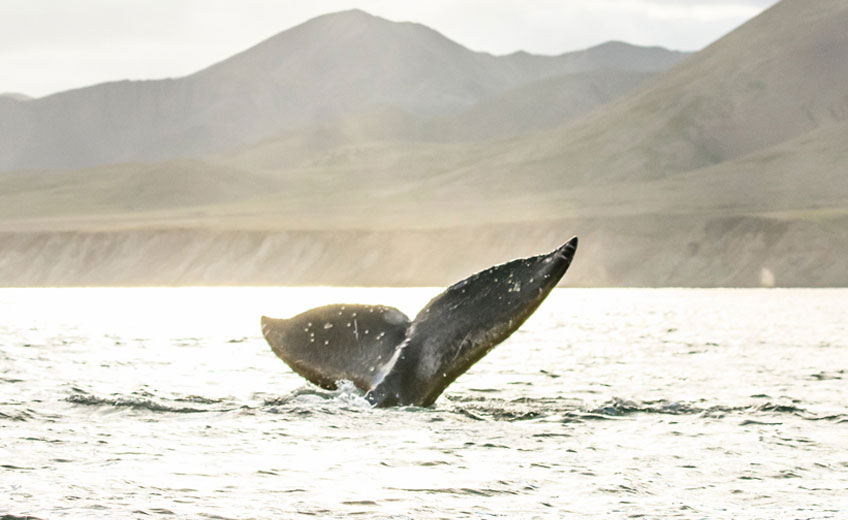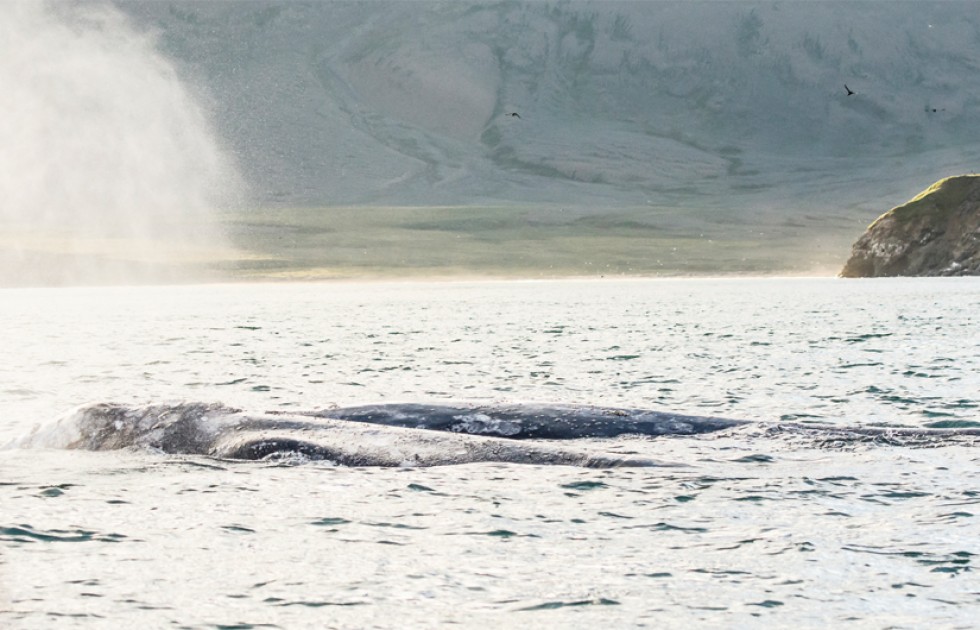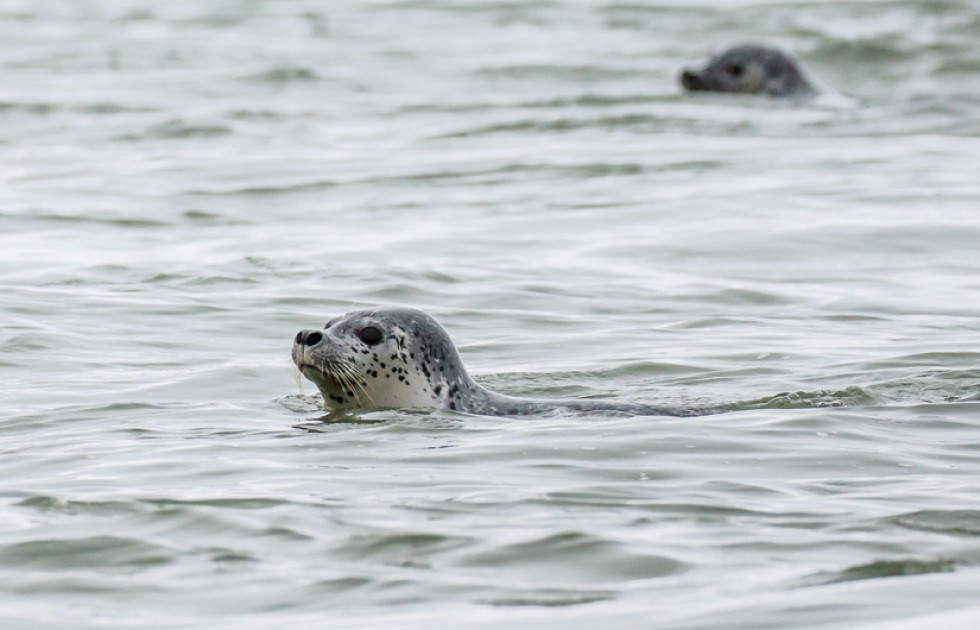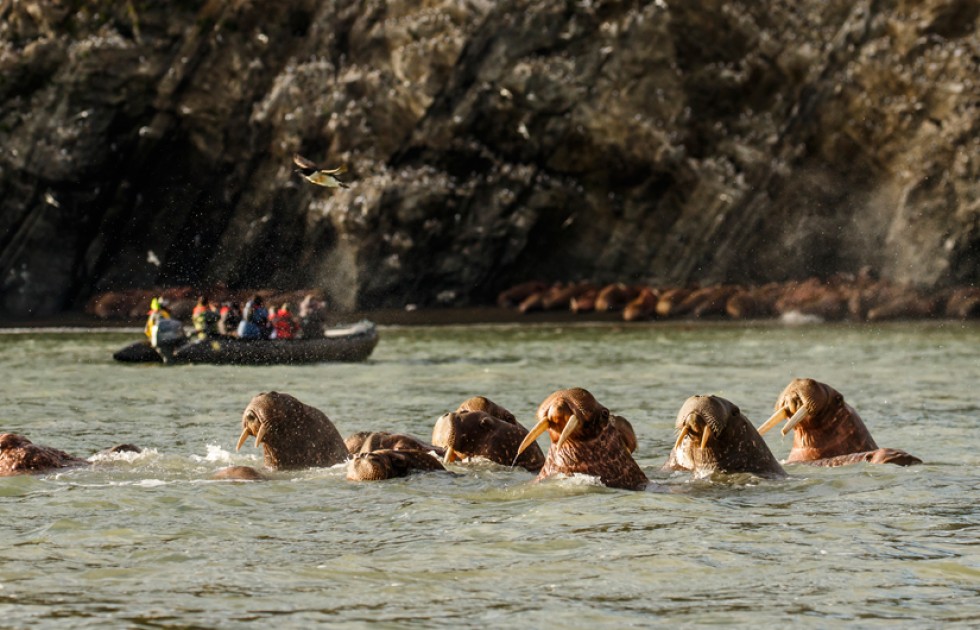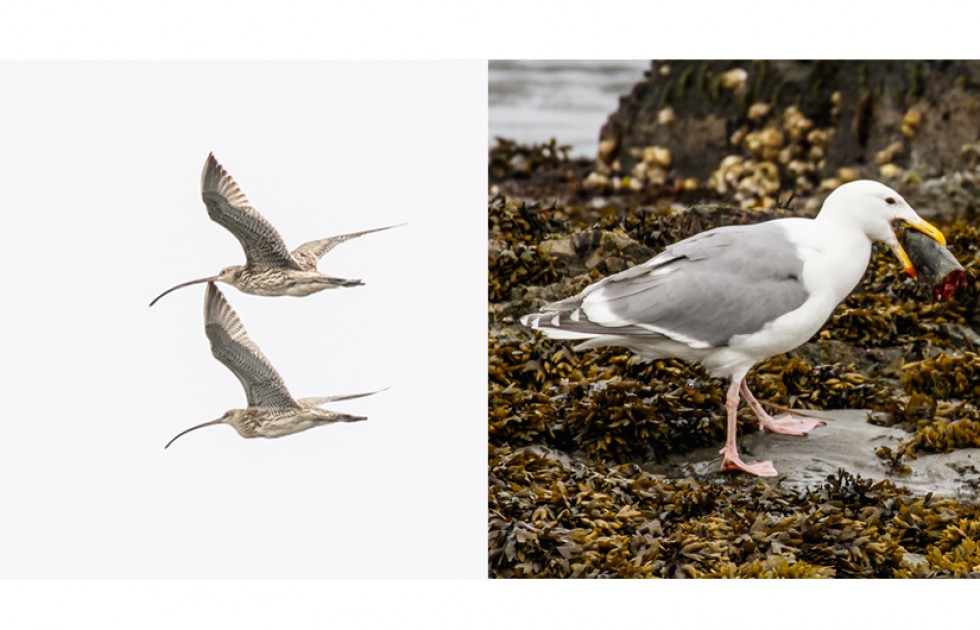In the previous issue of Elite+, I recapped my adventure aboard the Spirit of Enderby, an explorer ship carrying 50 passengers, sailing along the coastline of Kamchatka Peninsula in Russia Far East in search of Kamchatka brown bears and other wildlife species. I discovered that the various islands, bays, and lagoons where I visited were teeming with wildlife from mammals to birds. Besides about 40 brown bears I sighted, the other mammals encountered were grey whales, Largha seals, walrus, and several species of Kamchatka birds.
It was a thrilling experience to ride on a zodiac through rolling sea trying to photograph grey whales about 15 of which were sighted in Russia’s Bering Sea. Grey whale is a baleen whale with a length of 13 to 15 metres and weighs around 36 tons. It has a lifespan between 55 and 70 years.
A grey whale has two blowholes on the top of its head creating a V-shaped blow before submerging under water. It lacks a dorsal fin but has a dorsal ridge comprising six to 12 bumps on the midline of its rear quarter instead. Adult grey whales have distinctive encrusted barnacles on a large part of their heads.
Photographing whales in the sea from a zodiac is a most challenging venture. We sat, as standing not allowed, on a side of the zodiac which moved up and down according to the rhythm of the waves, while the whales were in the water. It was unpredictable where and when a whale would emerge; therefore, one must be fully alert with the camera ready. After having spotted and tried to photograph a few whales, I came to understand the nature and behavior of whales enabling me to anticipate and photograph the whale’s movement.
Grey whales feed on krill and amphipods which are very small krill-like marine animals range in size from one to 340 millimetres. As they dive to the sea floor in shallow water turning on their right side to feed, a fluke of the tail could be seen above the water.
The next mammal I confronted in the sea was the walrus. I was still in a zodiac but it was much easier to spot walrus than whale. However, it was not one or 20 walruses that I saw. There were about ten thousand walruses lying on a long stretch of beaches in front of us and some in the water looking curiously at our zodiacs. It was an all male hauling-out after the mating season while the females had their hauling-out at another site.
According to Wikipedia, hauling-out is the behavior associated with pinnipeds – true seals, sea lions, fur seals, and walruses – which temporarily leave the water between periods of foraging activity for sites on land or ice. The five zodiacs from the Spirit of Enderby approached the walrus haul-out site slowly and kept the distance. However, several walruses went into the water and swam as a group toward the zodiacs. When they came closer, we were relieved that it was the movement of curiosity rather than hostility. They also kept the distance from our zodiacs. We spent two hours observing and photographing those walruses then returned to the ship without any incident.
Another mammal species I saw in large number was largha seal or spotted seal which inhabited the coastal area, bays, and lagoons we visited. Largha seal is a “true seal” having no ears, which is different from sea lion which is “eared seal”. Largha seal has a body length of 1.5 to 2.1 metres and weighs 81 to 109 kilogrammes. It has a lifespan of 35 years. Adult largha seals feed on fish such as herring and arctic cod, while juveniles eat krill.
Besides mammals such as brown bears, whales, and walrus, another attraction which drew visitors to Kamchatka was diversified species of sea and shore birds. On the second day of the journey on the Spirit of Enderby, we ventured on the zodiacs into Zhupanova River, a well-known nesting site of Steller’s sea eagle, where we discovered 7 Steller’s sea eagles at their nests and two flying in the distance.
Steller’s sea eagle is one of the largest raptors in the world with a body length of 85 to 105 centimetres and a wingspan of 1.95 to 2.5 metred. Its weight ranges from 4.9 to 9.5 kilogrammes justifying a claim to be the heaviest living bird of prey. Its population is declining, and is listed by the IUCN (International Union on Conservation of Nature) as a vulnerable species facing high risk of endangerment in the wild. Steller’s sea eagle feeds mainly on fish, preferably salmon and trout.
Another bird species I spotted at Zhuapnova River was Far Eastern curlew flying in a herd of six. Far Eastern curlew is the world’s largest sandpiper with a body length of 60 to 66 centimetres and a wingspan of 110 centimetres. Its slightly curved long bill is measured at 12.8 to 20.1 centimetres in length.
Far Eastern curlews breed in northeastern Asia including Siberia, Kamchatka, and Mongolia and migrate during winter to Australia and southeast Asian countries. Its population is facing constant decline and is therefore listed by the IUCN as an endangered species.
One afternoon as the ship was sailing along the coast of Kamchatka Peninsula, I was standing at an open deck looking at the scenery. Then I saw a large bird which could be an albatross flying near the ship. I always carried my camera whenever I came up on the open deck and was able to take only one shot at that bird. A member of the ship’s expedition team later confirmed that the bird was a Laysan albatross.
Laysan albatross has a body length of 81 centimetres and a wingspan of 195 to 203 centimetres carrying a weight of 2.4 to 4.1 kilogrammes. Its plumage is different from the other albatross, looking more like a gull, with two tones of a dark grey mantle and wings and a white underside and head. It has a long lifespan of more than 60 years.
Laysan albatross feeds mainly on cephalopods and also fish and crustaceans. The IUCN once classified Laysan albatross as vulnerable because of drastic population decline due to wide-scaled hunting for feathers. But the recent survey has shown a trend of population increase, which prompted the IUCN to reclassify Laysan albatross as near threatened.
The Spirit of Enderby left the Kamchatka coast and visited the Commander Islands for two days. I found two interesting species of birds I didn’t find elsewhere during the trip which were glaucous-winged gull and rock sandpiper. The glaucous-winged gull is a large bird with a body length of 50-68 centimetres and a wingspan of 120 to 150 centimetres. It is a scavenger feeding on dead animals, fish, and mussels. Rock sandpiper is a medium-sized sandpiper with a body length of 20-23 centimetres. It feeds on insects, molluscs, marine worms, and crustaceans.
The Spirit of Enderby sailed further north leaving Kamchatka into Chukotka, the northernmost state half of which lies in the Arctic Circle. Due to limited space and more story to tell, I’d have to extend the recap of my adventure along the Siberia’s coast to the next issue of Elite+.


